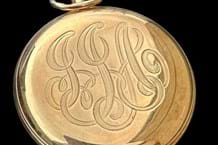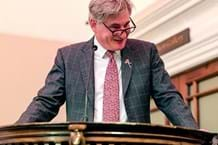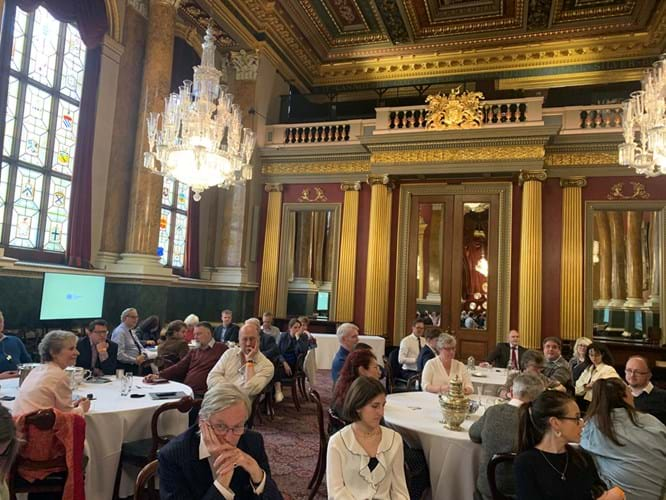
Guests at the one-day event at Goldsmiths’ Hall in the City of London on April 12, titled Marks of Deception: Tackling fakes & forgeries in antique British silver.
The event, titled Marks of Deception: Tackling fakes & forgeries in antique British silver, featured a session by London Silver Vaults dealer and Goldsmiths’ Hallmark Authentication Committee (GHAC) member Peter Cameron.
GHAC claims to have identified more than 40 faked de Lamerie objects offered on the market, including via auction houses, dealers and online markets such as eBay.
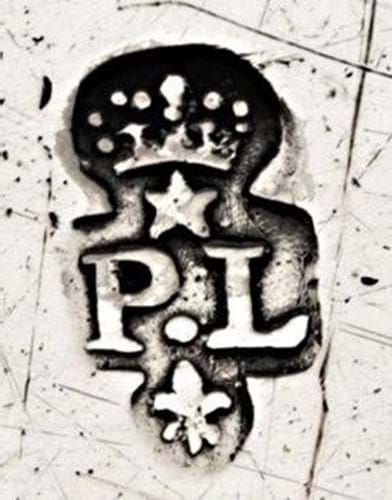
Some of the faked Paul de Lamerie (1688-1751) makers’ marks identified by the Goldsmiths’ Hallmark Authentication Committee (GHAC).
Cameron pointed to the 1990 exhibition on de Lamerie at Goldsmiths’ Hall that may have inadvertently helped the forger. “An unfortunate side effect was the catalogue by Susan Hare may have been used by those faking de Lamerie as a source of information as the catalogue detailed all his five makers marks.”
Among the objects that have been determined as fake were those using a ‘beaded’ crown mark (see images). The forgers used information on de Lamerie’s unregistered marks to create new punches but a number of errors alerted the specialists to the deception.
For instance, many of the date letters were incorrect as the forger had not accounted for the change from the Julian to the Gregorian calendar in 1752. This meant that the forger used marks together with date letters that could not have been used in the de Lamerie workshop.
On many of the pieces the forgers had attempted to suggest a false provenance by engraving the coats-of-arms of known de Lamerie customers. Some objects, such as mugs and tankards, were not commonly made by de Lamerie.
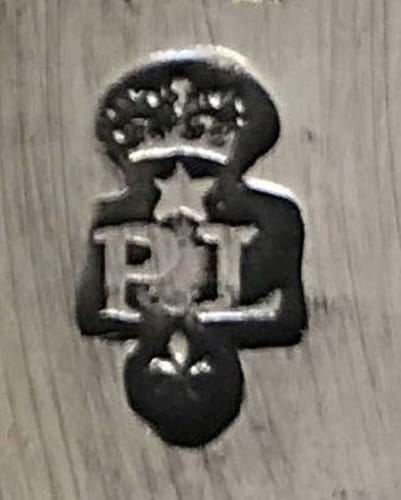
Some of the faked Paul de Lamerie (1688-1751) makers’ marks identified by the Goldsmiths’ Hallmark Authentication Committee (GHAC).
Cameron suggests specialists should “study these forged marks. Check the engravings and decoration and ask ‘does it look right’ and ‘does it make sense date-wise? Lastly, if in doubt check it with GHAC.”
Cameron hopes that a catalogue raisonné of de Lamerie could be compiled to help more easily identify suspect examples.

Some of the faked Paul de Lamerie (1688-1751) makers’ marks identified by the Goldsmiths’ Hallmark Authentication Committee (GHAC).
The Goldsmiths’ Company London Assay Office has run the Goldsmiths’ Hallmark Authentication Committee (GHAC) - formerly the Antique Plate Committee - since 1939.
Run by experts in the field, it advises on the authenticity of an object’s provenance based on the hallmark, professional analysis and a scientific analysis of its metals, and was put in place to protect consumers and uphold the law on hallmarks.
Anyone with an item that they are unsure of or have questions on can bring the item to be assessed by the committee.
Dr Timothy Schroder, chair of GHAC, said: “We are not a vetting committee at an antiques fair and not a police force. Instead the committee is like an advisory body and with the assay office we are helping to clean up the world of antique silver.”
Among the other updates during the one-day event at Goldsmiths’ Hall in the City on April 12 was a session from silver specialist and special adviser to the GHAC Alastair Dickenson, who spoke about the type of fakes in British silver from c.1700 to today.
He detailed the variety of items that can contravene the 1975 Hallmarking Act but noted that any objects without hallmarks and any foreign silver is outside the jurisdiction of this act.
The three main types of fakes and forgeries are:
- Transposed marks (cut out marks and stuck on);
- Illegal alterations or change of use;
- Counterfeit hallmarks
Transposed marks
One era where transposed hallmarks were common was the early 18th century when ‘duty dodgers’ (owners or silversmiths) did not send their items to be assayed during the period 1720-58 when a steep tax was placed on silver.
There were a variety of methods of escaping this tax – including transposing marks from small articles to large or overstriking marks from older pieces. These items are still illegal to sell.
Illegal alterations
For items that have been altered or a change of use made (ie adding a spout to a beaker to make a jug) it is only legal if specific addition marks were struck on the newly added addition (if over 5g).
Counterfeit hallmarks
Counterfeit hallmarks can be made in a number of ways including electroforming (copying the item, hallmarks and all); casting (either via the lost wax or sand casting method including the original marks); soft punches (made by copying other marks using copper); as well as fake steel punches created to make new, forged marks.
A number of famous cases involve talented silversmiths who have turned to forgery and Dickenson highlighted their various techniques and methods.
The one-day seminar attracted attendees including valuers and specialists from auction houses, collectors, dealers and many more.
The sold-out event had been delayed due to an IT issue at the Goldsmiths’ Company and was warmly welcomed by the trade after five years away.
Other sessions during the day included Will Evans, director of the London Assay Office, on scientific testing and new processes; Eleni Bide, Goldsmiths’ Company librarian, on the available resources at the library including an extensive archive; plus a roundtable handling session of fakes and forgeries to help attendees see just how skilled and difficult to spot some of the fakes are.


